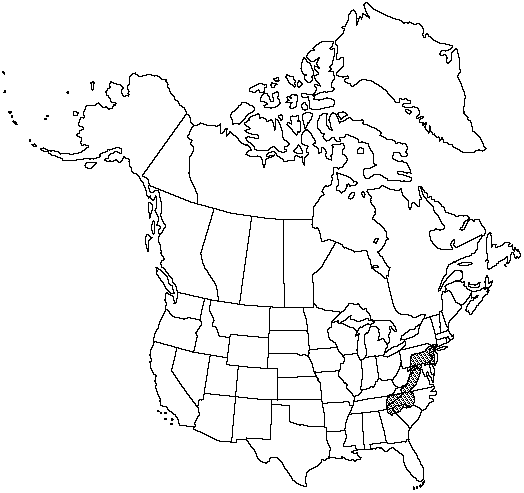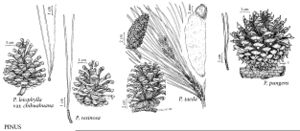Difference between revisions of "Pinus pungens"
Ann. Bot. (London) 2: 198. 1805.
FNA>Volume Importer |
imported>Volume Importer |
||
| (6 intermediate revisions by 2 users not shown) | |||
| Line 8: | Line 8: | ||
}} | }} | ||
|common_names=Table mountain pine;mountain pine | |common_names=Table mountain pine;mountain pine | ||
| + | |special_status={{Treatment/ID/Special_status | ||
| + | |code=F | ||
| + | |label=Illustrated | ||
| + | }}{{Treatment/ID/Special_status | ||
| + | |code=E | ||
| + | |label=Endemic | ||
| + | }} | ||
|basionyms= | |basionyms= | ||
|synonyms= | |synonyms= | ||
| Line 23: | Line 30: | ||
|elevation=500–1350m | |elevation=500–1350m | ||
|distribution=Del.;Ga.;Md.;N.J.;N.C.;Pa.;S.C.;Tenn.;Va.;W.Va. | |distribution=Del.;Ga.;Md.;N.J.;N.C.;Pa.;S.C.;Tenn.;Va.;W.Va. | ||
| − | |discussion=<p>Pinus pungens is a scrub pine and is too small and knotty to be much utilized except for pulpwood and firewood. Its common name refers to a general type of landform, not to a specific, named mountain.</p> | + | |discussion=<p><i>Pinus pungens</i> is a scrub pine and is too small and knotty to be much utilized except for pulpwood and firewood. Its common name refers to a general type of landform, not to a specific, named mountain.</p> |
|tables= | |tables= | ||
|references= | |references= | ||
| Line 32: | Line 39: | ||
-->{{#Taxon: | -->{{#Taxon: | ||
name=Pinus pungens | name=Pinus pungens | ||
| − | |||
|authority=Lambert | |authority=Lambert | ||
|rank=species | |rank=species | ||
| Line 45: | Line 51: | ||
|publication title=Ann. Bot. (London) | |publication title=Ann. Bot. (London) | ||
|publication year=1805 | |publication year=1805 | ||
| − | |special status= | + | |special status=Illustrated;Endemic |
| − | |source xml=https:// | + | |source xml=https://bitbucket.org/aafc-mbb/fna-data-curation/src/2e0870ddd59836b60bcf96646a41e87ea5a5943a/coarse_grained_fna_xml/V2/V2_811.xml |
|genus=Pinus | |genus=Pinus | ||
|species=Pinus pungens | |species=Pinus pungens | ||
Latest revision as of 20:25, 5 November 2020
Trees to 12m; trunk to 0.6m diam., straight to crooked, erect to leaning, poorly self-pruning; crown irregularly rounded or flattened. Bark red- to gray-brown, irregularly checked into scaly plates. Branches horizontally spreading; twigs slender, orange- to yellow-brown, aging darker brown, rough. Buds ovoid to cylindric, red-brown, 0.6–0.9cm, resinous. Leaves 2(–3) per fascicle, spreading or ascending, persisting 3 years, 3–6(–8)cm × 1–1.5mm, twisted, deep yellow-green, all surfaces with fine stomatal lines, margins harshly serrulate, apex acute to short-acuminate; sheath 0.5–1cm, base persistent. Pollen cones ellipsoid, ca. 15mm, yellow. Seed cones maturing in 2 years, variably serotinous, mostly whorled, downcurved, asymmetric, ovoid before opening, broadly ovoid when open, (4–)6–10cm, gray- to pale red-brown, nearly sessile or on stalks to 1cm; apophyses thickened, diamond-shaped, strongly keeled, elongate, mammillate at cone base abaxially; umbo central, a stout, curved, sharp claw. Seeds deltoid-obovoid, oblique; body ca. 6mm, deep purple-brown to black; wing 10–20(–30)mm. 2n =24.
Habitat: Dry, mostly sandy or shaly uplands, Appalachians and associated Piedmont
Elevation: 500–1350m
Distribution

Del., Ga., Md., N.J., N.C., Pa., S.C., Tenn., Va., W.Va.
Discussion
Pinus pungens is a scrub pine and is too small and knotty to be much utilized except for pulpwood and firewood. Its common name refers to a general type of landform, not to a specific, named mountain.
Selected References
None.
